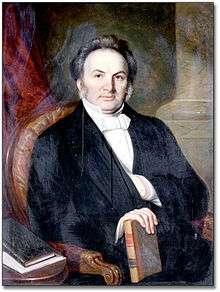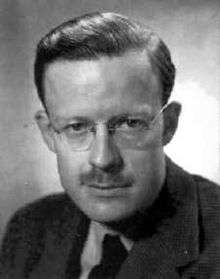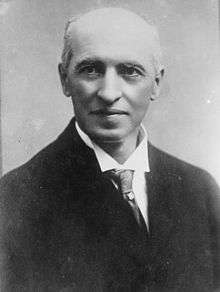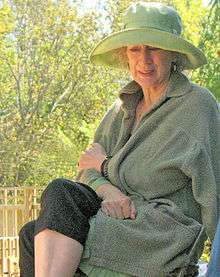Victoria University, Toronto
Victoria University is a college of the University of Toronto, founded in 1836 and named in honour of Queen Victoria. It is commonly called Victoria College, informally Vic, after the original academic component that now forms its undergraduate division. Since 1928, Victoria College has retained secular studies in the liberal arts and sciences while Emmanuel College has functioned as its postgraduate theological college.
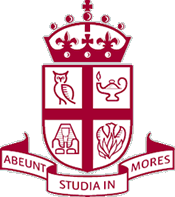 | |
Former names | Upper Canada Academy (1836–1841) Victoria College (1841–1884) |
|---|---|
| Motto | Abeunt studia in mores |
Motto in English | Studies pass into character |
| Established | October 12, 1836 |
Parent institution | University of Toronto |
| Endowment | C$506.7 million[1] |
| Chancellor | Carole Taylor |
| President | William Robins |
| Principal | Angela Esterhammer (Victoria College), Phyllis Airhart (Emmanuel College) |
| Undergraduates | 3,084[2] |
| Location | |
| Mascot | Lion |
| Website | www |
Victoria is situated in the northeastern part of the university campus, adjacent to St. Michael's College and Queen's Park. Among its residential halls is Annesley Hall, a National Historic Site of Canada. A major centre for Reformation and Renaissance studies, Victoria is home to international scholarly projects and holdings devoted to pre-Puritan English drama and the works of Desiderius Erasmus.
History
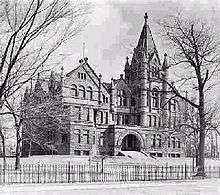

Victoria College was founded as the Upper Canada Academy by the Wesleyan Methodist Church. In 1831, a church committee decided to locate the academy on four acres (1.6 hectares) of land in Cobourg, Ontario, east of Toronto, because of its central location in a large town and access by land and water. In 1836, Egerton Ryerson received a royal charter for the institution from King William IV in England, while the Upper Canadian government was hesitant to provide a charter to a Methodist institution. The school officially opened to male and female students on October 12, 1836, with Ryerson as the first president and Matthew Richey as principal.[3] Although the school taught a variety of liberal arts subjects, it also functioned as an unofficial Methodist seminary. In 1841, it was incorporated as Victoria College, named in honour of Queen Victoria, and finally received a charter from the Upper Canadian Legislature.[4]
John Harper (architect) designed Victoria University Medical College (1871-2), Gerrard Street East at Sackville Street, Toronto which was demolished.[5]
Victoria University was formed in 1884 when Victoria College and Albert University federated with each other. In 1890, Victoria University federated with the University of Toronto. In 1892, Victoria University moved from Cobourg to its current campus on Queen's Park Crescent, south of Bloor Street (at Charles Street West), in Toronto.
A plaque was erected at 100 University Avenue at the intersection with College Street in Cobourg, Ontario.
Victoria College The cornerstone of this building was laid June 7, 1832, and teaching began in 1836. First operated under a royal charter by the Wesleyan Methodists as Upper Canada Academy, in 1841 it obtained a provincial charter under the name of Victoria College, giving it power to grant degrees. Victoria’s first president was the Reverend Egerton Ryerson, newspaper editor and founder of Ontario’s present educational system. In 1890 the college federated with the University of Toronto and, in 1892, left Cobourg.
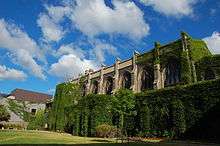
James Loudon, a former president of the federated universities, had prohibited dancing at the University of Toronto until 1896. However, dancing at Victoria was not officially permissible until thirty years later, in 1926.
King George V gifted to Victoria College a silver cup used by Queen Victoria when she was a child and the Royal Standard that had flown at Osborne House and was draped on the coffin of the Queen when she died there in 1901.[6]
Two bronze plaques on either side of the outside door of Victoria College were erected as memorials dedicated to the students of Victoria College who lost their lives in the First and Second World Wars. The WWI list of honour was erected by the Alumni and Alumnae Associations on October 13, 1923 while the WWII list of honour was erected by the Board of Regents.[7]
In 1928, the independent Union College federated with the theology department of Victoria College, and became Emmanuel College.
On the old Ontario strand for piano by Joyce Belyea was published for the Victoria College Music Club between 1946 and 1948 by the J.H. Peel Music Pub. Co. in Toronto.[8]
Sites and architecture

Victoria College is somewhat separated from the rest of the University of Toronto geographically, bordering Queen's Park, and being located on the eastern portion of the campus along with St. Michael's College. The main building, Old Vic, an example of Richardsonian Romanesque architectural style, was built in 1891. The architect was W. G. Storm, who died shortly after completion. The campus is centred on the main quadrangle of Victoria, outlined by the upper and lower houses of Burwash Hall.
The oldest residence building at Victoria is Annesley Hall. Built in 1903 and renovated in 1988, it is a National Historic Site of Canada located across from the Royal Ontario Museum. Annesley Hall was the first residence built specifically for women in Canada.

Burwash Hall is the second oldest of the residence buildings at Victoria. Construction began in 1911 and was completed in 1913. It was named after Nathanael Burwash, a former president of Victoria. The building is an extravagant Neo-Gothic work with turrets, gargoyles, and battlements. The architect was Henry Sproatt.
The building is divided between the large dining hall in the northwest and the student residence proper. The residence area is divided into two sections. The Upper Houses, built in 1913, consist of four houses: North House, Middle House, Gate House, and South House. The Lower Houses were built in 1931 and were originally intended to house theology students at Emmanuel College, whose current building was opened the same year. Ryerson House, Nelles House, Caven House, Bowles-Gandier House are now mostly home to undergraduate arts and science students. The latter two are mostly reserved for students in the Vic One Programme.
To the west the Upper Houses look out on the Vic Quad and the main Victoria College building across it. West of the Lower Houses is the new Lester B. Pearson Garden of Peace and International Understanding and the E.J. Pratt Library beyond it. From the eastern side of the building, the Upper Houses look out at Rowell Jackman Hall and the Lower Houses see the St. Michael's College residence of Elmsley. The only exceptions are the view from Gate House's tower that looks down St. Mary's Street and the view from the south side of Bowles-Gandier house, which looks upon the main quadrangle of St. Michael's University College.
Rowell Jackman Hall, is the newest of Vic's residences, having been completed in 1993. It is named after Mary Rowell Jackman whose son Hal Jackman made a substantial donation to the project. It stands just to the east of Burwash Hall on Charles St. and is west of St. Michael's College Loretto College. Before Rowell Jackman Hall was built, the site was home to a parking lot and the historic Stephenson House. Prior to construction Stephenson House was moved to a new location further east on Charles St. The building's construction caused some controversy as it greatly disrupted life in Burwash.
Margaret Addison Hall is a seven-floor co-ed residence across Charles St. from Burwash Hall, between the Goldring Student Centre and the Victoria sports field.
Built in 1961 and located at the south end of the quadrangle, the E.J. Pratt Library the main library of Victoria University, with some 250,000 volumes. The collection is geared towards the undergraduates and contains mainly humanities texts with a focus on History, English, and Philosophy. The site of the library and the adjacent Northrop Frye Building was originally on the route of Queen's Park Crescent. The road was pushed south into Queen's Park to make way for the new buildings.
Academics and organization
Victoria University is governed bicamerally by the Victoria University Board of Regents and the Victoria University Senate. These bodies are represented by faculty, administrators, elected students and alumni. The colleges are governed by the Victoria College Council and Emmanuel College Council. College councils are represented by faculty, administrators and elected and appointed students. Victoria's governing charter was most recently amended in 1981, with the enactment of the Victoria University Act.[9]
Victoria is presently the wealthiest college at the University of Toronto by net assets. In part this has been because of alumni donations, but much of the growth is specifically due to the rapidly increasing value of Victoria's large real estate holdings in downtown Toronto. Today, the College has a securities portfolio worth approximately $78 million and a real estate portfolio worth $80 million.
The E.J. Pratt Library is the main library of Victoria College. The Centre for Reformation and Renaissance Studies holdings fall into three main categories: rare books, most of which were printed before 1700 (currently about 4,000 titles), modern books (currently about 25,000 volumes), and microforms (several thousand microfiches and reels). The library contains primary and secondary materials relating to virtually every aspect of the Renaissance and Reformation. In particular, it houses the Erasmus collection, one of the richest resources in North America for the study of works written or edited by the great Dutch humanist Desiderius Erasmus of Rotterdam. The collection holds a substantial number of pre-1700 editions of his works, including the Novum Instrumentum of 1516.
The academic programs of the college include Literary Studies, Semiotics and Communication Theory, Renaissance Studies, the Vic Concurrent Teacher Education Program (developed in conjunction with OISE/UT) and the first-year undergraduate programs Vic One and Vic First Pathways.[10]
Centre for Reformation and Renaissance Studies (CRRS) is a research and teaching centre in Victoria University devoted to the study of the period from approximately 1350 to 1700. The CRRS supervises an undergraduate program in Renaissance Studies, organizes lectures and seminars, and maintains an active series of publications. The centre also offers undergraduate, graduate, and postdoctoral fellowships. From 1976 to 2009, the performance history research and publishing project Records of Early English Drama (REED) was based at Victoria University.
Student life

Campus life for Victoria students is active and varied. Victoria College has levy receivers, student organizations that directly receive a fixed amount of funding from students every year, as well as clubs whose funding are overseen by the Victoria University Students' Administrative Council (VUSAC). Clubs include the Environmental Fashion Show, PlenTea to Talk About, Vic Dance and the Victoria College Chorus.[11]
Levy receivers are students groups with special status based on providing an essential service for student life, and levy heads are also assessor members in VUSAC. Victoria's twelve levy receivers are:[12]
- Acta Victoriana, the college literary journal.
- Victoria College Drama Society (VCDS), which runs at least four shows per year (a fall show, a winter show, a submission to the University of Toronto Drama Festival, and a musical)
- The Strand, Vic's student-run newspaper that is distributed fortnightly across the University of Toronto's downtown campus.
- Victoria College Athletics Association (VCAA), which provides students with a chance to participate and compete in intramural sports.
- The Cat's Eye, a student lounge in the Goldring Student Centre building that is often used to hold events.
- The Victoriad, the yearbook.
- WUSC, which sponsors a student from a developing country to come to the University of Toronto.
- Caffiends, Vic's student-run fair trade organic cafe.
- VicPride!, an LGBTQ organization that strives to create a safe space at Victoria.
- Student Projects, a fund available to students to finance projects that will enrich student life.
- VicXposure, a photography group offering workshops, equipment rentals and darkroom use.
- VISA, the Victoria International Students Association.
Victoria is also home to the Isabel Bader Theatre, opened in March 2001. During the past few years the theatre has been used as a lecture hall for University of Toronto students, an active learning space for Victoria University students groups, numerous concerts, film screenings, conferences, and theatrical productions, including the annual sophomore tradition launched in 1872, The Bob Comedy Revue, each written, directed, produced and performed by students such as Lester B. Pearson, Norman Jewison, E. J. Pratt, Northrop Frye, and Margaret Atwood.[13]
Residential halls and houses
Annesley Hall is the all-female residence at Victoria College. Annesley Hall is the first university residence built for women in Canada.[14]
Burwash Hall residences consist of the Upper and Lower Houses, each type differing slightly in their layout. The Upper Houses were gutted and renovated in 1995. The Lower Houses have only been partially upgraded. Before the renovations the entire building was all male, but now every house in Burwash is co-ed.
Gate House is one of the four Upper Houses of Burwash Hall. Until 2007, when Victoria administration made it co-ed, Gate House was one of the last remaining all-male residence building in the University of Toronto.[15] The Gate House emblem is the Phoenix, visible in the bottom-right corner of the Victoria College insignia. Gate House, with the rest of Upper Burwash, opened in 1913 and has held students every year since then except 1995, when it was renovated.[16] Gate House has three floors which house 28 students.
The eight storey Rowell Jackman Hall building is an apartment style residence with each floor divided into a number of suites. The interior is ascetic: a combination of plastic runners and gray linoleum tile. When it was completed Rowell Jackman Hall was mainly home to upper years and graduate students. Today it only houses undergrads and has a considerable number of first years, except for International House, which continues to house a number of upper years.
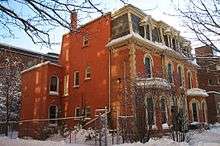
Stephenson House was a community involvement residence at Victoria University and hosted ten undergraduate students per year. Stephenson House was self-governed and self-regulating with a separate application and selection process. It last functioned as a residence in the 2009–2010 academic year.
Burwash Dining Hall
The Burwash Dining Hall holds some 250 students and sixteen large tables. Hanging on the western wall is Queen Victoria's burial flag, given to the college soon after her death. Under the flag is the high table where the professors and college administration lunch. Historically, the Upper Houses each had their own table. Gate sat in the southwest corner, Middle sat in the far northeast, South sat in the table to the west of Middle, while North sat to the west of the southeast corner. The only lower house to have had a designated table was Caven, in the northwest corner beside the Alumni table. (Note that prior to the 1995 renovations, some of these houses, particularly North and Caven, 'traditionally' sat elsewhere)
Culture and traditions
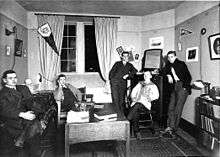
For 20 years Gate House hosted an annual party called Novemberfest in the Burwash dining hall.[17] The Victoria Dean of Students cancelled Novemberfest in 2003, when police discovered widespread underage drinking and over 800 people in the dining hall, in violation of the fire code.[18] Another Gate House tradition that no longer occurs is the "stirring the chicken," a dinner and keg party where house members cook chicken fajitas for hundreds of guests. Until 2007, Gate House held secretive first-year initiation ceremonies called Traditionals, which involved writing slogans on campus buildings in chalk, singing songs to the all-women's residence (who would then sing back to them), and leading first-years around the house blindfolded.[19]
During its 93 years as a men's residence, Gate House developed a distinct fraternity-like character and reputation. These antics included pranks, toga parties, streaking, caroling to other residences, hazing rituals, "beer bashes" and "incessant pounding" on the Gate House table in the dining hall.[20][21] Paul Gooch wrote that these traditions gave Gate House an "ethos" that contradicted his vision of residence life.[21]
The all-male Gate House was known to many as a social centre and spirited, tight-knit community. According to Grayson Lee, who created a snow penis sculpture in 2007, an important tipping-point in the dissolution of the house, most of its residents were "heartbroken" to leave.[22] Former Gate House President Dave Ruhl commented that "the Gate House camaraderie is unique" and that living there was "one of the most important parts of the university experience" for many.[21]
The Reuters news agency nicknamed Gate House "U of T's Animal House" because Donald Sutherland's (himself a resident of South House residence) memories of its parties are said to have influenced the script of the 1978 movie.[22] The Toronto Star described Gooch's decision to put an end to its traditions, activities and distinguishing characteristics as "neutering Animal House."[23]
Notable alumni and faculty
Famous Victoria alumni include Margaret Atwood, Lester B. Pearson, Don Harron, and Donald Sutherland.
- Ellery Armstrong-DeJongh - cool gal
- Margaret Atwood – author
- Margaret Avison – poet
- Frederick Banting – attended; Nobel Prize in Physiology or Medicine, 1923
- William Black Creighton – social reformer
- George Blewett – philosopher and theologian
- John Royston Coleman – economist, president of Haverford College, host of CBS program Money Talks
- Wilbur R. Franks – noted scientist and cancer researcher
- Northrop Frye – literary critic
- Jessa Gamble – author and science journalist
- Peter Godsoe – president and CEO of Bank of Nova Scotia, 1992–2003; chairman of Fairmont Hotels and Resorts and Sobeys, chancellor of the University of Western Ontario, 1996–2000
- Blake Goldring – executive chairman of AGF Management Limited
- W. G. Hardy – professor, writer, president of the International Ice Hockey Federation, Member of Order of Canada[24]
- Don Harron – comedian
- Lawrence Ho – billionaire businessman, chairman & CEO, Melco Crown
- Henry Horricks – pacifist and anti-racism activist
- Norman Jewison – former chancellor of Victoria University and Academy Award-winning (Irving G. Thalberg Memorial Award) filmmaker
- Ted Jolliffe – Rhodes scholar and first leader of the Ontario section of the Co-operative Commonwealth Federation (CCF)
- Ndahura II Imara Kashagama – King of Busongora Kingdom [Central Africa]
- Andromache Karakatsanis – Canadian Supreme Court justice – first Greek-Canadian judge on the court
- Jay Macpherson – poet
- Don McKellar – actor and filmmaker
- John Fletcher McLaughlin – prominent theologian
- Philip Orsino – president and CEO of Masonite International Corporation, 1989–2005
- Richard Outram – poet
- Steve Paikin – journalist
- Lester B. Pearson – former Prime Minister of Canada and Nobel Laureate
- E. J. Pratt – poet
- Laure Rièse – first female faculty member
- Egerton Ryerson – one of the founders of Victoria College and its first president
- Arthur L. Schawlow – physicist, Nobel laureate
- Arthur Sifton – second premier of Alberta
- Augusta Stowe-Gullen – first woman to graduate from a Canadian medical school
- Donald Sutherland – Academy Honorary Award-winning actor
- Carole Taylor – former minister of finance of British Columbia, former chancellor of Simon Fraser University
- Kenneth D. Taylor – former chancellor of Victoria University and former Canadian ambassador to Iran
- Vaira Vīķe-Freiberga – 6th president of Latvia
- Bob Young – entrepreneur, co-founder of Red Hat
References
- "Victoria University : Financial Statements : April 30, 2019" (PDF). Vicui.utoronto.ca. Retrieved May 8, 2020.
- Pask-Aubé, Corinne (2016). University of Toronto Facts and Figures (PDF). Office of Government, Institutional and Community Relations.
- The Project Gutenberg EBook #6466 of 'The Intellectual Development of the Canadian People, A historical review' by John George Bourinot, House of Commons, Ottawa, February 17th, 1881
- Pound, Richard W. (2005). Fitzhenry and Whiteside Book of Canadian Facts and Dates. Fitzhenry and Whiteside.
- "Archived copy". Archived from the original on 2012-04-25. Retrieved 2011-11-10.CS1 maint: archived copy as title (link)
- Rynor, F. Michah (2001). "Royal Gems". UofT Magazine. Toronto: University of Toronto (Winter 2001). Retrieved 3 October 2009.CS1 maint: ref=harv (link)
- Canada, Library and Archives (27 November 2008). "Link to this page". Amicus.collectionscanada.gc.ca. Retrieved 20 December 2018.
- "Archived copy". Archived from the original on 2007-08-20. Retrieved 2018-12-20.CS1 maint: archived copy as title (link)
- "Archived copy". Archived from the original on 2007-03-29. Retrieved 2007-04-12.CS1 maint: archived copy as title (link)
- "VUSAC – CLUBS". Victoria-university. Retrieved 20 December 2018.
- "VUSAC". Vusac.ca. Retrieved 2016-09-11.
- "Despite cuts and critics, Bob carries on". Thenewspaper.ca. Retrieved 20 December 2018.
- "Annesley Hall National Historic Site of Canada". Canada's Historic Places. Parks Canada. Retrieved 2012-08-22.
Annesley Hall was designated a national historic site because it is a particularly good example of the Queen Anne Revival style, as expressed in institutional architecture. Designed by architect G. M. Miller, and built in 1902-1903, Annesley Hall was the first purpose-built womens’ residence on a Canadian university campus.
- Taylor, Bill (2007-12-19). "Party's over at U of T residence". Toronto Star. Retrieved 2007-12-19. Italic or bold markup not allowed in:
|publisher=(help) - Houghton, Sarah (2003-03-12). "One Hundred Years of Architecture". The Strand. Archived from the original on 2007-05-25. Retrieved 2007-06-05.
- Tsang, Sharon (2002-12-04). "'Student aspect' of Vic liquor license suspended". The Strand. Archived from the original on 2007-09-28. Retrieved 2007-06-05.
- Salonen, Rachel (2002-01-22). "'Student pub taken out of students' hands". The Strand. Archived from the original on 2007-09-28. Retrieved 2007-06-05.
- Bao, Jane (2007-01-07). "'Boy's club dismembered". The Varsity. Archived from the original on 2008-01-19. Retrieved 2007-01-08.
- Richards, Jason (2004-09-18). "'Gate House Traditionals Exposed". The Strand. Archived from the original on 2007-09-28. Retrieved 2007-06-05.
- Taylor, Bill (2007-12-19). "'Party's over at U of T residence". Toronto Star. Retrieved 2007-12-19. Italic or bold markup not allowed in:
|publisher=(help) - Sibonney, Claire (2007-12-19). "'University of Toronto's Animal House laid to rest". Reuters. Italic or bold markup not allowed in:
|publisher=(help) - Taylor, Bill (2007-12-19). "'Party's over at U of T residence". Toronto Star. Retrieved 2007-12-19. Italic or bold markup not allowed in:
|publisher=(help) - Peacock, Jim (May 3, 1958). "Writing Is His Hobby". Lethbridge Herald. Lethbridge, Alberta. p. 4.

Further reading
- Martin L. Friedland The University of Toronto: A History (Toronto: University of Toronto Press © 2002)
- Neil Semple Faithful Intellect: Samuel S. Nelles And Victoria University (Montreal: McGill-Queen's University Press, September 1, 2004)
- C. B. Sissons A History of Victoria University. Toronto: University of Toronto Press, 1952.
External links
| Wikimedia Commons has media related to Victoria University, Toronto. |
- Official website

- Archival papers of William James Callahan, President of Victoria College (1991-2000), held at the University of Toronto Archives and Records Management Services

